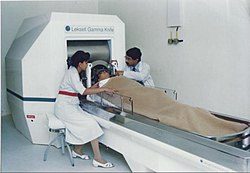Early history
Ancient

Trepanation, similar to some techniques used today, is the oldest surgical procedure known and was practised in the Stone Age in many parts of the world, [3] and in some areas may have been quite widespread. The main pieces of archaeological evidence are in the forms of cave paintings and human remains. One third of 120 skulls found at a site in France dating to 6500 BCE had undergone trepanning. [4] It was also practised widely in the pre-Columbian Andes. [5] [6] These procedures were mostly performed on combatants, with evidence from skeletal remains revealing that the earliest methods usually resulted in death. [6] However, by the 1400s, Incas proved to be "skilled surgeons", as survival rates rose to about 90%, infection rates following the procedure were low and evidence was found showing that some individuals survived the surgery on multiple occasions. [6] Incan surgeons learned to avoid areas of the head that would cause injury, using a scraping method on the skull that would cause less trauma. [6] They also likely used medicinal herbs of the time, such as coca and alcohol for pain while balsam and saponin would be employed for antibiotic purposes. [6]
An ancient Egyptian treatise concerning trauma surgery, the Edwin Smith papyrus, contains descriptions and suggests treatments for various injuries, including some of neurological nature. Specifically, there are descriptions of the meninges, the external surface of the brain, the cerebrospinal fluid and the intracranial pulsations. [7] Not only are these neurological features mentioned, but it is also noticed that some bodily functions can be impaired by brain injuries or injuries to the cervical spine. [7] There are many other examples of observations of neurological phenomena throughout history. The Sumerians illustrated paraplegia caused by physical trauma in a bas relief of a lion with an arrow in its back. [8] Neurological disorders not caused by physical disorder were also investigated. Buddha's physician, Jīvaka Komārabhacca, performed surgery to remove two parasites from a patient's brain in the 5th century BCE. [9]

Slightly later, the ancient Greek physician Hippocrates was convinced that epilepsy has a natural cause, not a sacred one. [10] The ancient Greeks also dissected the nervous system. For example, Aristotle (although he misunderstood the function of the brain) describes the meninges and also distinguishes between the cerebrum and the cerebellum. [11] Slightly later, in Rome, Galen performed many dissections of the nervous system in a variety of species, including the ape. One particular discovery he made was of the importance of the recurrent laryngeal nerves. Originally, he cut through them accidentally while performing an experiment on the nerves that control breathing by vivisection of a strapped-down, squealing pig. The pig immediately stopped squealing, but continued struggling. Galen then performed the same experiment on a variety of animals, including dogs, goats, bears, lions, cows and monkeys, finding similar results each time. Finally, to publicise this new result, Galen demonstrated the experiment on a pair of pigs to a large audience in Rome, telling them: "there is a hairlike pair [of nerves] in the muscles of the larynx on both left and right, which if ligated or cut render the animal speechless without damaging either its life or functional activity". [12]
With surgery, Hua Tuo was an ancient Chinese physician and surgical pioneer who is said to have performed neurosurgical procedures. [13] In Al-Andalus from 936 to 1013 AD, Al-Zahrawi evaluated patients and performed surgical treatments of head injuries, skull fractures, spinal injuries, hydrocephalus, subdural effusions and headache. [14] Concurrently in Persia, Avicenna also presented detailed knowledge about skull fractures and their surgical treatments. [15]




